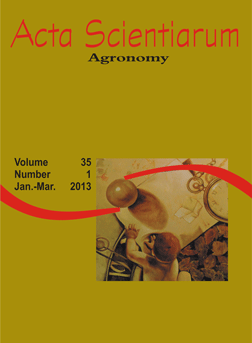<b>Pathogenic, morphological and genetic diversity in <i>Plasmopara halstedii</i>, the causal agent of sunflower downy mildew</b> - doi: 10.4025/actasciagron.v35i1.15722
Resumo
Pathogenic, morphological and genetic variation was studied in 35 Plasmopara halstedii (sunflower downy mildew) isolates of different races. Virulence spectrum was analyzed in sunflower hybrids carrying effective Plgenes. Aggressiveness was analyzed in one sunflower inbred line showing a high level of quantitative resistance. There were differences in virulence spectrum for pathogen isolates. Index of aggressiveness was calculated for each isolate and two groups were revealed as more aggressive isolates of 100 and 3xx races, and less aggressive isolates of 7xx races. Significant morphological differences were found in zoosporangia and sporangiophores morphology. Genetic relationships were detected between the pathogen isolates using 12 EST-derived markers. Five multilocus genotypes (MLG) were identified among 35 P. halstedii isolates. Our results did not show a correlation between pathogen variation and both morphological and genetic characteristics.
Downloads
DECLARAÇÃO DE ORIGINALIDADE E DIREITOS AUTORAIS
Declaro que o presente artigo é original, não tendo sido submetido à publicação em qualquer outro periódico nacional ou internacional, quer seja em parte ou em sua totalidade.
Os direitos autorais pertencem exclusivamente aos autores. Os direitos de licenciamento utilizados pelo periódico é a licença Creative Commons Attribution 4.0 (CC BY 4.0): são permitidos o compartilhamento (cópia e distribuição do material em qualqer meio ou formato) e adaptação (remix, transformação e criação de material a partir do conteúdo assim licenciado para quaisquer fins, inclusive comerciais.
Recomenda-se a leitura desse link para maiores informações sobre o tema: fornecimento de créditos e referências de forma correta, entre outros detalhes cruciais para uso adequado do material licenciado.




















































